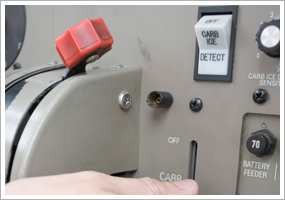| The following stories from the July 10, 2009, edition of AOPA ePilot were provided to AOPA members who expressed an interest in the particular subject areas. Any AOPA member can receive information tailored to their areas of interest by updating their preferences online. - My ePilot -- Helicopter Interest -Bell 429 helicopter certified in CanadaTransport Canada Civil Aviation (TCCA) has certified Bell’s newest light twin helicopter, the 429. Bell has also completed the FAA’s certification requirements. Bell said that multiple customer advisory boards were established and consulted throughout the 429’s design and manufacturing phases to gather input on what customers want in a light twin engine helicopter. The result is a helicopter that meets or exceeds every critical design element identified by the customer boards. Read more >> ELITE S623 helicopter simulator certifiedElite Simulation Systems of Orlando, Fla., has received FAA Advanced Aviation Training Device (AATD) certification for its ELITE S623 helicopter simulator. The certification allows for the maximum flying hour credits that can be awarded to a helicopter FTD. This includes 20 hours flying credit toward the instrument rating, 25 hours toward the commercial rating, and 25 hours toward the ATP rating. The device can be used for instrument proficiency checks (IPCs) and instrument currency requirements, and 2.5 hours may go toward the helicopter private pilot certificate. Read more >>
TRAINING TIPsCarb heat technique
Flight training operations requiring multiple power adjustments or sustained flight at low power settings make training aircraft especially susceptible to carb icing, as discussed in the Aug. 23, 2002, Training Tip. If you suspect carb icing because of a gradual power loss or engine roughness, act promptly and aggressively to eliminate it. In most aircraft equipped with carbureted engines, that means applying full carb heat until normal operation has been restored.
If carb icing was present, chances are that the engine’s response to your actions will confirm your suspicions in dramatic fashion. “The first time you experience carb ice can be startling, since application of full carb heat—as recommended—will likely cause brief coughing and choking in the engine as the ice in the carburetor melts and is ingested by the engine,” explains the AOPA Air Safety Foundation’s Safety Advisor Engine Operations. Then engine operation should become smooth, and the power setting you were maintaining before the icing should resume—so let the carb heat do its work.
There are preventive steps you can take when cruising toward your destination on a day when carb icing conditions prevail. “When icing conditions exist, apply carburetor heat often at your cruise throttle setting. Never use partial carburetor heat unless the aircraft is equipped with a carburetor temperature gauge, ice light, or similar instrumentation. Partial heat can possibly make matters worse, unless you know exact carburetor temperatures,” advises the comprehensive discussion of carb ice in the AOPA Online Pilot Information Center. “Remember, full heat or nothing. When below the green band on the rpm or MP gauge, apply carburetor heat. It is good practice to use it on any descent where you have reduced power.”
Proper use of carb heat is safety in its simplest and most effective form. TRAINING PRODUCTSQref moves into aircraft checklistsQref Media, manufacturer of avionics checklists, has expanded its product line to include checklists for popular aircraft models. Twenty-three models are available for Cessna, Cirrus, Diamond, and Piper aircraft, with new models to be added each week. They are available in two formats: the compact, multi-page “Q’Book,” and the single-page, double-sided “Q’Card.” Both styles measure approximately 4.5 inches by 8 inches and feature large type and a full-color format. Prices start at $12.95 for Q’Cards and $19.95 for Q’Books. Order online from the Web site, or call 877/660-7733. Note: Products listed have not been evaluated by ePilot editors unless otherwise noted. AOPA assumes no responsibility for products or services listed or for claims or actions by manufacturers or vendors. FINAL EXAMQuestion: I recently moved to a new address and, following the regulations, notified the FAA of my address change within 30 days. I have not received any response from the FAA. Am I still allowed to use my student pilot certificate even though it has my old address on it?
Answer: You are permitted to use your student pilot certificate even though it does not contain your current address. The FAA does not mail out new pilot certificates every time a pilot moves. Instead, the address change is updated in the FAA records and in the airman database. You can verify that the FAA has your current address by viewing your listing in the airman database. Got a question for our technical services staff? E-mail to [email protected] or call the Pilot Information Center, 800/872-2672. Don't forget the online archive of "Final Exam" questions and answers, searchable by keyword or topic. |
 Warmer temperatures and high humidity create many challenges for pilots, including reduced aircraft performance, thunderstorm development, and rapid fog formation when temperature-dewpoint spreads narrow. These are also the conditions that elevate the risk of aircraft with carbureted engines developing ice in the carburetor throat, with potential for power loss or even engine stoppage. Do you use correct technique to minimize the risk? Can you recognize the signs of carburetor icing’s onset?
Warmer temperatures and high humidity create many challenges for pilots, including reduced aircraft performance, thunderstorm development, and rapid fog formation when temperature-dewpoint spreads narrow. These are also the conditions that elevate the risk of aircraft with carbureted engines developing ice in the carburetor throat, with potential for power loss or even engine stoppage. Do you use correct technique to minimize the risk? Can you recognize the signs of carburetor icing’s onset?